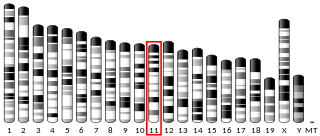MNT (Max-binding protein MNT) is a Max-binding protein that is encoded by the MNT gene [5] [6] [7]
MNT (Max-binding protein MNT) is a Max-binding protein that is encoded by the MNT gene [5] [6] [7]
The Myc/Max/Mad network comprises a group of transcription factors that co-interact to regulate gene-specific transcriptional activation or repression. This gene encodes a protein member of the Myc/Max/Mad network. This protein has a basic-Helix-Loop-Helix-zipper domain (bHLHzip) with which it binds the canonical DNA sequence CANNTG, known as the E box, following heterodimerization with Max proteins. Its delta signature is 44. This protein is a transcriptional repressor and an antagonist of Myc-dependent transcriptional activation and cell growth. This protein represses transcription by binding to DNA and recruiting Sin3 corepressor proteins through its N-terminal Sin3-interaction domain [5] [8]
MNT (gene) has been shown to interact with MLX, [9] [10] SIN3A [11] and MAX. [11]
Myc is a family of regulator genes and proto-oncogenes that code for transcription factors. The Myc family consists of three related human genes: c-myc (MYC), l-myc (MYCL), and n-myc (MYCN). c-myc was the first gene to be discovered in this family, due to homology with the viral gene v-myc.

MYC proto-oncogene, bHLH transcription factor is a protein that in humans is encoded by the MYC gene which is a member of the myc family of transcription factors. The protein contains basic helix-loop-helix (bHLH) structural motif.

Paired amphipathic helix protein Sin3a is a protein that in humans is encoded by the SIN3A gene.

Tripartite motif-containing 28 (TRIM28), also known as transcriptional intermediary factor 1β (TIF1β) and KAP1, is a protein that in humans is encoded by the TRIM28 gene.

MAX is a gene that in humans encodes the MAX transcription factor.

MAX-interacting protein 1 is a protein that in humans is encoded by the MXI1 gene.

MAD protein is a protein that in humans is encoded by the MXD1 gene.

Max-like protein X is a protein that in humans is encoded by the MLX gene.

Max-interacting transcriptional repressor MAD4 is a protein that in humans is encoded by the MXD4 gene.

Midline-2 is a protein that in humans is encoded by the MID2 gene.

GTP-binding protein ARD-1 is a protein that in humans is encoded by the TRIM23 gene.

Tripartite motif-containing 22, also known as TRIM22, is a protein which in humans is encoded by the TRIM22 gene.

Carbohydrate-responsive element-binding protein (ChREBP) also known as MLX-interacting protein-like (MLXIPL) is a protein that in humans is encoded by the MLXIPL gene. The protein name derives from the protein's interaction with carbohydrate response element sequences of DNA.

E3 ubiquitin-protein ligase TRIM33, also known as (ectodermin homolog and tripartite motif-containing 33) is a protein encoded in the human by the gene TRIM33, a member of the tripartite motif family.

Tripartite motif-containing protein 16 is a protein that in humans is encoded by the TRIM16 gene.

Tripartite motif-containing protein 9 is a protein that in humans is encoded by the TRIM9 gene.
The tripartite motif family (TRIM) is a protein family.

Tripartite motif-containing protein 6 is a protein that in humans is encoded by the TRIM6 gene.

Tripartite motif-containing protein 11 is a protein found in humans that is encoded by the TRIM11 gene.

Tripartite motif-containing protein 15 is a protein that in humans is encoded by the TRIM15 gene.
This article incorporates text from the United States National Library of Medicine, which is in the public domain.